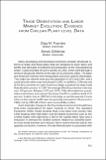Artículo
Trade orientation and labor market evolution: Evidence from chilean plant-level data
Fecha
2005Resumen
Many developing and developed economies consider structural reforms to trade and fiscal policy that are designed to lower taxes and tariffs and stimulate investment and production of the manufacturing sector. A good example of such a country is Chile, which went through a series of structural reforms in the late 1970s and early 1980s. The labor and financial markets were deregulated and price controls eliminated. Two major tax reforms were put into operation in 1975 and 1984, and a social security reform was introduced in 1980. In addition, Chile was one of the first countries in Latin America to begin a gradual but deep trade liberalization process. In 1967 the average effective protection rate was over 100 percent. Between 1973 and 1979, Chile eliminated the quantitative restrictions and reduced the import tariff to a uniform level of 10 percent. A debt crisis in 1982 led to the delay or partial reversal of some reforms (the import tariffs were temporarily increased to 35 percent in 1984), but by 1992 all of them were successfully in place.
Colecciones
Descargar


